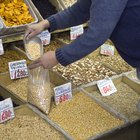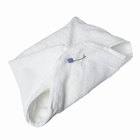
Cellophane and polypropylene are both used to package food and other products. As a food packaging, cellophane is easier to manipulate and costs more than polypropylene. Both products are approved by the U.S. Food and Drug Administration.
Cellophane
Cellophane is a paper product made from wood pulp. It was invented in 1900 and has been continuously manufactured since the 1930s. Cellophane allows moisture to pass through, preventing condensation. In addition to food packaging, cellophane is used to wrap flowers and gifts, and to make adhesive tape.
Polypropylene
Polypropylene is a thermoplastic polymer derived from crude oil. It is used to make plastic products such as packaging containers; wrap for food and other products; and fiber products including carpet, rope and clothing. Polypropylene is stronger than cellophane but must be heat-sealed or taped to close.
Environmental Considerations
Cellophane is made from plants so is biodegradable, however toxic chemicals including carbon disulfide and sulfuric acid are used in the manufacturing process. Polypropylene is a petroleum-based product that does not readily break down. Plastics can be recycled, though separating the component chemicals is not easy, and different types of plastic must be sorted before recycling.
Related Articles

Types of Biodegradable Products

Heating Foods in Plastic & BPA

What Is Polyurethane Coated Leather?

Plastic Recycling Levels

What Are the Dangers of Plastic Bags ...

What Items Can't Be Recycled?

How to Remove Silk Wraps

List of Plants Used for Clothing

What Types of Foam Can Be Recycled?

Alcohol in Fermented Miso Paste

The Differences Between Fleece & ...

Microfleece Vs. Microplush

How to Store Clothes in Cardboard Boxes

What Is Synthetic Hair Made Of?

How to Buy Play-Doh in Bulk

How to Make Hydrolyzed Silk Protein

The Manufacturing Process of Cosmetics

How to Wrap Large Gifts for a Bridal ...

List of Biodegradable, Every Day ...

How to Remove Ink From Nylon
References
Resources
Writer Bio
Lisa Jensen grows organic food and lives in an adobe house that she built. She teaches aikido, is an experienced back-country skier and backpacker and is active in her community. A graduate of the University of Calgary, Jensen writes about gardening, home projects, social sciences and sports and recreation.
Photo Credits
Jupiterimages/Photos.com/Getty Images